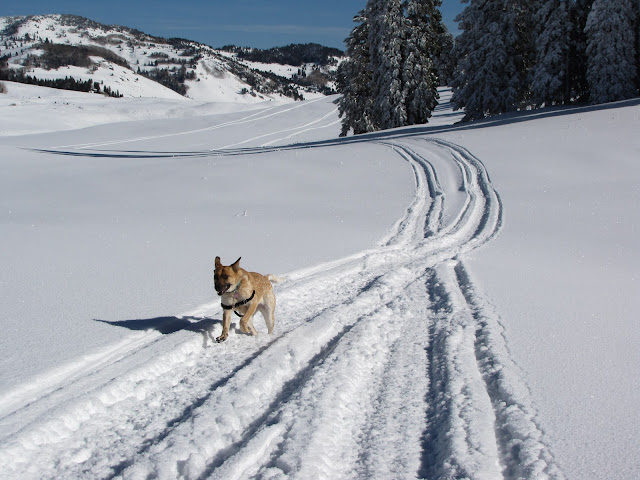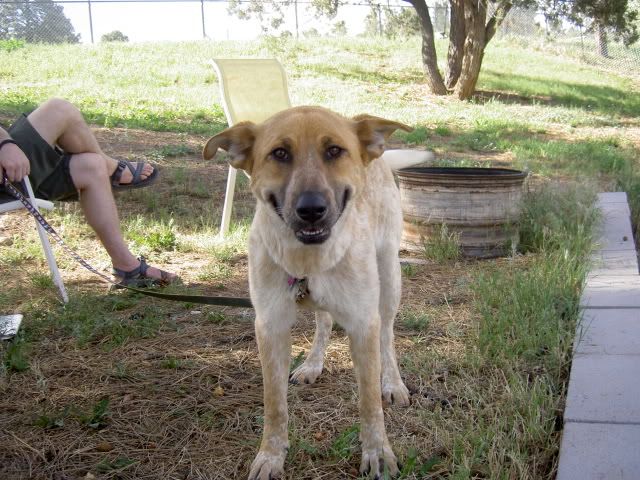Earlier this month, I wrote about
teaching Maya an "outside" cue. At the time, I was thinking hard about my relationship with my dog -- what it was, what it is, what I want it to be. I think about this a lot, really.
The "outside" cue has become part of our regular schedule. One unexpected problem has arisen, however. When I started teaching Maya to signal her desire to go out, it was bitterly cold. She just wasn't that interested in spending time out there. Since then, it's warmed up considerably. The snow has mostly melted, there are wonderfully sunny days, and the ground is a lovely mixture of frozen and thawed.
On nice days, Maya would prefer to spend a lot of time outside. Especially if I am busy. So she gives the signal on a very frequent basis, and I have to decide whether to "listen." Any time I get up and open the back door, I reinforce the behavior, and Maya has learned to tolerate disappointment, so it doesn't matter too much whether I comply at a 100%, 60%, or 10% rate -- the behavior is still solid, and Maya doesn't pitch temper tantrums over noncompliance.
She has important business outside. There are things to sniff, a neighbor's dog who needs watching, and, from a certain corner, a glimpse of activities out on the street. The squirrel who lives near our woodpile is active, birds fly in and out (less interesting than squirrels, but still worth noting), and patches of sun are made for sunbathing. Maya loves being in the yard.
But she has a few problematic behaviors. The neighbor's dog sometimes charges the fence, which means Maya needs to charge back, and a major barking festival ensues. Activities on the street also provoke barking. Most problematically, Maya will charge our fence when our neighbors on either side seek to use their back yards. I don't permit this behavior to continue, and am hoping to eventually eliminate it (difficult, but may be possible), and listening/watching for it takes a fair amount of my attention from other projects.
So I answer to my cues only when it suits me, and this seems to be fine with Maya. The only cue that she hates me to ignore is "dinner," and she will get fussy if I ignore it too frequently or for too long. All in all, I am happy with this experiment, even if it isn't quite as transgressive or transformative as it initially felt.
One other thought: I wrote in the earlier post that when she first came home, "I needed Maya to accept my version of the world ("it is safe"), and could not listen to or give credence to hers ("everything is very dangerous, bark bark bark")."
By "not listening to" her version of the world, I don't mean that I didn't listen to what she was saying. Maya was shouting, with every fiber of her being, that the world was a scary and overwhelming place. I listened. We shrunk her world to a manageable size, and taught her to deal with it.
There is a piece of advice that nice people often give me about Maya, which is to just "let her get over it." Go about my daily activities, ignore her distress signals, and just let her figure out how to cope. I will probably write more about this sometime, but the short answer is that this course of action would have utterly destroyed Maya. Her ability to deal with the world was so marginal, and the world caused her so much distress, that figuring out coping mechanisms was physically and mentally beyond her capabilities. It would have been like trying to learn trigonometry while your house was on fire, assuming you had no background in basic mathematics and that learning trig was an absolute requirement for maintaining your safety and sanity.
My project is not to tune Maya out, but to help her re-think how she sees the world. And in doing that, I couldn't just accept her version of events...I had to carefully set things up so that she'd start to perceive things in a new light. And in so doing, I listened to Maya really carefully. I just didn't necessarily adopt her views.













